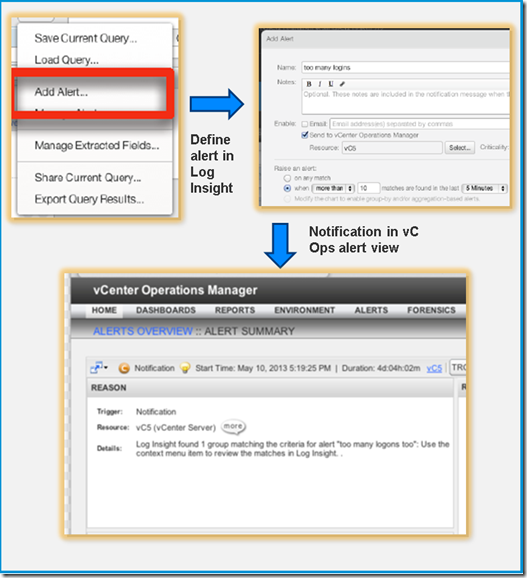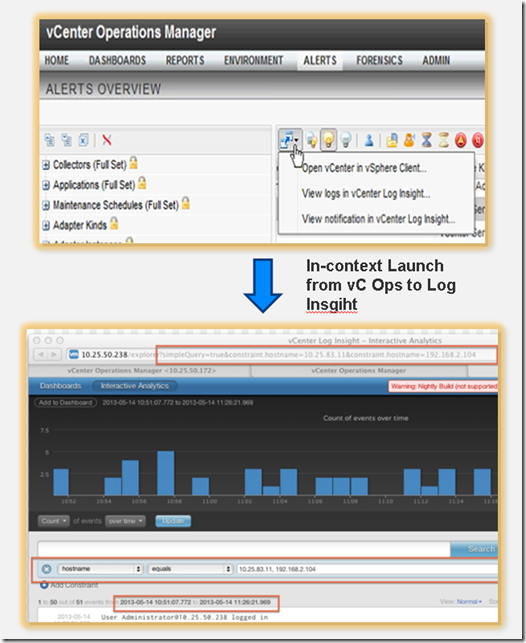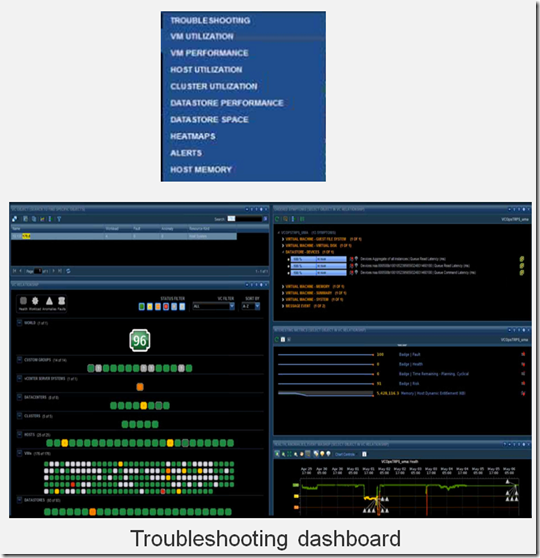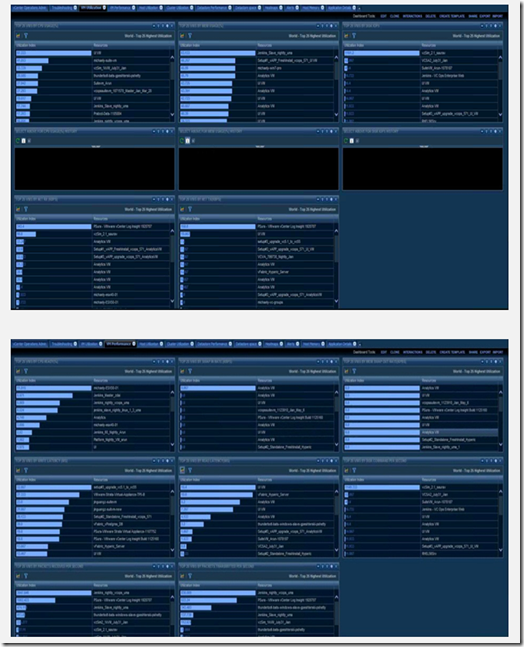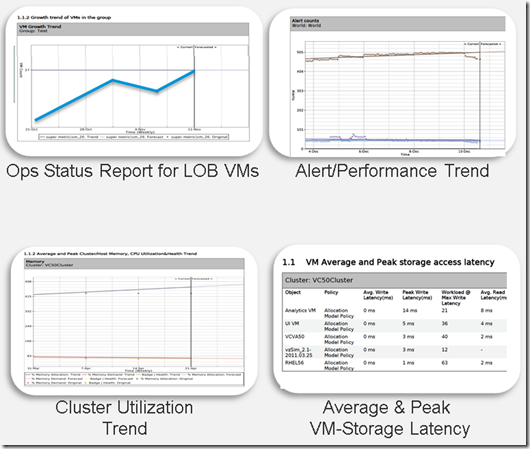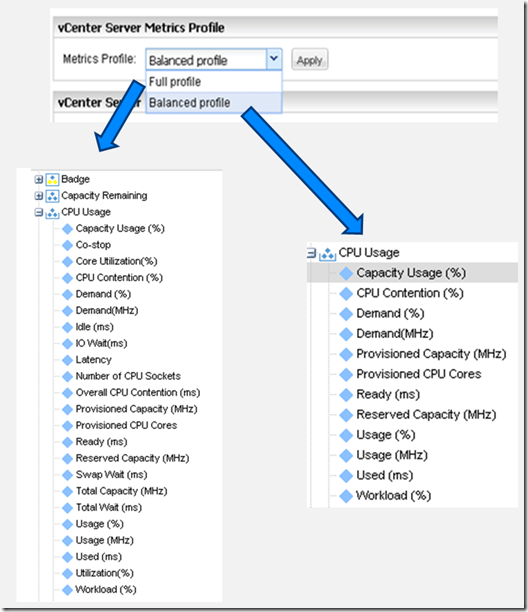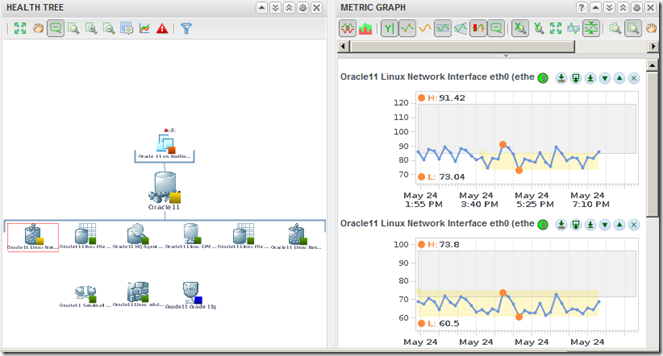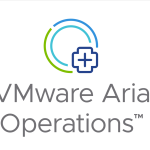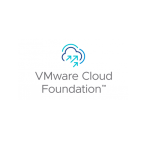Last week, we not only launched vCenter Log Insight, which we are very excited about, we also released vCenter Operations Management Suite version 5.7.1. This update includes vCenter Operations Manager 5.7.1 and vFabric Hyperic 5.7. I wanted to point out a few highlights of these releases and walk you through some of the enhanced functionality, product integrations and platform updates. So let’s see the latest that we have for each product.
vCenter Operations Managerprovides you with operations dashboards to gain deep insights and visibility into health, risk and efficiency of your infrastructure, and also includes performance management and capacity optimization capabilities. The enhancements in the 5.7.1 release focus on:
- Tight Integration with vCenter Log Insight, for faster troubleshooting and enhanced visibility across your IT environment.
- New reports and dashboards, based on best practices, to help you save time and improve efficiency.
- Security and infrastructure enhancements, for improved hardening and scalable performance.
vFabric Hypericprovides comprehensive application monitoring to quickly find and fix performance problems for custom web applications. The improvements in this release are all about:
- Enhanced integration with vCenter Operations Manager, improving usability and scale.
- Updated, as well as new plugins, with support for newer versions, as well as improved features.
- Security and platform support updates, for Java, Windows and AIX.
Important Side Note: As I mentioned above, last week we also announced the beta release of vCenter Log Insight, which is a fantastic new product that provides automated log management through log analytics, aggregation and search. You can read about the business benefits and market perspective in Ramin Sayar’s blog post, and get the lowdown on the technology behind this new offering in Jon Herlocker’s blog post.
Now let’s cover these updates in detail:
vCenter Operations Manager 5.7.1
- Integration with vCenter Log Insight
With this release, you can get event notifications from vCenter Log Insight in to vCenter Operations, as well as launch Log Insight in-context from vCenter Operations Manager. This enables a seamless transition from monitoring to troubleshooting.
The screenshot below shows the integration view in vCenter Operations that shows performance SLAs, overlaid with change events and log events.
Moreover, you can select any object in vCenter Operations and launch vCenter Log Insight in-context to search for logs, enabling you to follow the trail from vCenter Operations to vCenter Log Insight, quickly traversing the last mile to root cause, and helping reduce time to resolve issues.
- New reports and dashboards
There are number of new dashboards available:
- Dashboards for vSphere utilization and performance indicatorsbased on VMware best practices, that include the 10 top customer requested dashboards showing KPIs for a vSphere environment – Troubleshooting (for any resource), VM Utilization, VM Performance, Host Utilization, Cluster Utilization, Datastore Performance, Datastore Space, Heatmaps, Alerts, and Host memory.
- Dashboards showing key VM metrics, with top 25 lists to identify the top consumers of VM resources at-a-glance. They show top 25 CPU, memory, disk, network I/ charts to quickly identify high utilization, and also key metrics to identify VM performance issues (CPU ready, Swap in, Latency CMD/S, Packets/sec), and the top users.
- Host and cluster dashboardsto isolate issues quickly and see the top 25 resource consumers at-a-glance. These include host utilization (CPU, memory, disk, network I/O charts), host memory (detect memory constraints, analyze host and VM memory utilization, granted, consuming, shared memory, constraints, swaps, long term stress), as well as cluster utilization dashboards.
- Datastore dashboards to identify top IO resource and space consumers.
- Heatmap and Alerts dashboardsto display metrics for CPU, Disk, Memory and Network for easy comparison, as well as provide additional troubleshooting information.
- New reports that help you save time in sending weekly operational status of a VM group to LOB/App owner; help you assess performance impact to clusters/datastores from increased VMs/demand over last week; and help you to identify which clusters, datastores, VMs had performance problems last week.
|
Report Name |
Description / Use case |
|
Operational Status Summary Report for a Group/LOB |
Send out historical operational status summary of a group of VMs belonging to a LOB/App owner. |
|
Health badge & Alert Trend Report |
Correlate which of your VMs/Hosts/Datastores had high alert count and performance/capacity problems last day/week. |
|
Average Cluster Utilization Trend Report |
Assess performance/capacity risk to a cluster from newer VM deployments or increased peak usage over the last day/week/month etc. |
|
Average Datastore Latency & Throughput Report |
Assess performance/capacity risk to datastores from newer VM deployments or increased usage over the last day/week etc. |
|
Average & Peak VM-Storage Access Latency Report |
Assess average and peak VM storage accesslatencies over the last day/week etc. to re-evaluate sizing or placement. |
-
Security and infrastructure enhancements
This release also includes various security hardening updates, to satisfy the most stringent DISA STIG guidelines related to password complexity and expirations, permission hardening, SSH hardening, audit requirements, DoD banners for console and SSH, 14 character minimum password length, profile message flood protection, and more.
Additionally, infrastructure improvements have been made to the Balanced Profile feature to deliver scalability without comprising functionality. Balanced profile will be the default profile for fresh installations. However, in case of upgrades, the previously selected profile will be not be changed.
What’s more, this release include interoperability support for vSphere 5.5, as well as enhancements to custom UI widgets.
vFabric Hyperic 5.7
-
Enhanced integration with vCenter Operations Manager
With the version 5.7 release, we have taken some solid steps towards a more usable and scalable integration between Hyperic and vCenter Operations Manager. Now you get automatic app to VM correlation in vCenter Operations, a new API adapter to push metrics in a scalable manner, ability to automatically send only key metrics, as well as in-context drill down from the vCenter Operations dashboard to Hyperic.
The screenshot below shows an example of the app (Oracle11 in this case) to VM correlation in vCenter Operations, enabled with Hyperic 5.7.
-
Updated, as well as new plugins
Hyperic 5.7 includes the following updated plugins:
-
Updated .NET plugin with support for Microsoft .NET 3.5 and 4.0 (including data providers).
-
Updated JBoss plugin that supports JBoss 7.1
-
Updated Active Directory plugin to support Windows 2008R2 and Windows 2012
-
Other updates include IIS plugin with IIS8 support, major bug fixes in MSSQL plugin, Microsoft Exchange plugin that includes monitoring CAS service, and WebSphere MQ plugin with support for non-standard installation paths.
The new plugins are:
-
Microsoft SharePoint plugin
-
A new log tracking plugin to enable support for more log files.
-
Security and platform support updates
This release includes support for Java 7, since Java 6 is EOL. We have updated the backend Postgres to 9.1.9, and fixed a major security vulnerability found in Postgres 9.1.3.
In terms of platform support, we now support Windows 2012 and AIX 7.1 as well.
There are additional scalability and deployment improvements in Hyperic 5.7. You can now add deployment profiles for small, medium and large deployments as part of the virtual appliance deployment wizard. In addition, we have made agent scale improvements to support hundreds of SNMP monitored nodes per agent.
So as you can see, there are a lot of exciting and very useful updates in today’s release. We hope you take advantage of the new features, and continue to give us your feedback.
Current users can update/upgrade by downloading from here, and new users can obtain free trials of vCenter Operations as well as vFabric Hyperic.
If you have questions, please visit the respective Community Forums for vCenter Operations Manager and vFabric Hyperic. And yes, be sure to follow us on twitter @vCenterOps.
Thanks for reading!
Himanshu Singh (@himanshuks)

